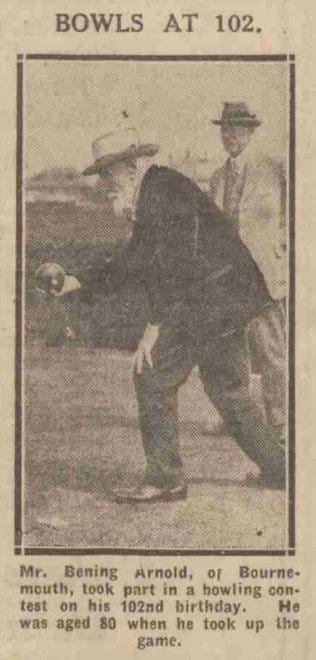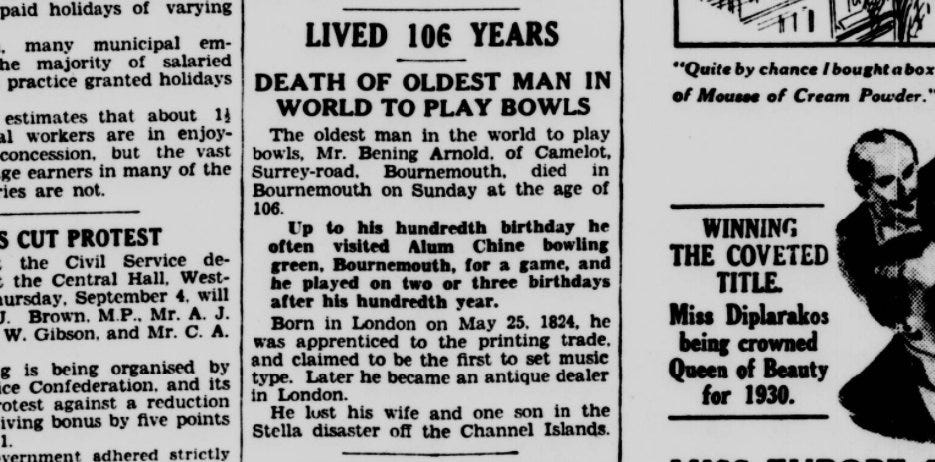Oldest Man in World to Play Bowls
Life after the Stella disaster; PLUS special guest Chris Lee on the origins of football
In a previous newsletter, we told the story of Bening Arnold, a 14-year-old boy who survived the shipwreck of the SS Stella, the “Titanic of the Channel Islands”, after being Saved by a Football. Bening was travelling with his mother Emilie and his younger brother Claude from Southampton to meet his father in Guernsey. Both Emile and Claude perished in the wreck. Bening’s father, also named Bening Arnold, spent several days searching for news of his family, eventually finding his surviving son in France and bringing him home to recover.
Bening Arnold Snr. was 75 at the time of the Stella disaster. Emilie, 37 years his junior, was his second wife. They had been married for 15 years. Emilie was a talented artist and designer and spoke six languages. “The deceased lady was of great assistance to her husband in the business, and was highly accomplished,” noted a counsel at the inquiry into the disaster. “Consequently, her death was a great loss to Mr Arnold.” Arnold was awarded damages of £692 for the loss of his wife and youngest son and “a considerable quantity of valuable jewellery and clothing”.
Arnold had a long and interesting life. He was born on 25 May 1824. As a boy, he ran away from his Essex school and travelled on a barge to London to make his fortune. He worked as an apprentice in the printing trade and claimed to be the first man to print music from set type — an endeavour that required many more complex elements than printing text.
He later became a well-known chronometer maker, jeweller, silversmith, and antique dealer, with a shop on London’s Baker Street — near to the fictional home of Sherlock Holmes. (“Bening Arnold guarantees all his watches and cleans them free of charge as often as required,” stated his London newspaper advert. “None but the best quality.”)
Arnold retired two years after the Stella disaster to Bournemouth on the south coast of England. He became well known in later life as a successful bowls player. (That’s lawn bowls, the game played on a bowling green, where players must roll their bowls closest to a jack.) Arnold, “Bournemouth’s grand old man”, took up bowls at the age of 80 and continued playing for more than two decades. As he grew older, newspapers regularly reported on his progress.
At 99, it was reported, his daily regime began at 7.30 AM with a hearty breakfast, followed by a walk of nearly a mile uphill to catch a bus to the bowling green. After a full morning of bowling, he spent his afternoons gardening and his evenings playing cribbage, then went to bed at 9.30 PM. “My rule of life has been to take plenty of fresh air and exercise and to be temperate at all things,” he said, adding that he was a non-smoker but not a teetotaller.
On his 102nd birthday, well-wishers and bowlers from around the country gathered at the Alum Chine Bowling Green in Bournemouth to watch him play. Arnold, wearing a Panama hat and velveteen smoking jacket, smiled, shook hands, and “saluted the ladies present”. During the game, in which he was said to hold his own easily, he acknowledged the crowd's cheers by waving his hat. Shortly after his 103rd birthday, a doctor ordered him not to play again as the excitement was “a little too much for him”.
Bening Arnold Snr. died in 1930 at the age of 106. At the time of his death, he was believed to be the oldest man in England. His passing was reported in London’s Daily Herald under the headline: “Death of Oldest Man in World to Play Bowls.” ⧫
Next, special guest Chris Lee on the global origins of football:
Recommended:
Origin Stories by Chris Lee
Football — some say soccer — is the most popular game in the world, and this book explains why. Origin Stories: The Pioneers Who Took Football to the World is a globe-hopping chronicle of how association football went global. Author Chris Lee, who also runs the Outside Write football website and podcast, introduces a global cast of characters whose enthusiasm for the early game set us on the path towards the phenomenon that is modern football. The book has remarkable scope, travelling from England and Scotland, to Wales and Ireland, then across to France and Western Europe, and over to Argentina and South America, then up to North America, back to Europe, and eventually to the Middle East, Africa, and the Asia-Pacific. Each chapter covers a different country, introducing the pioneering individuals and clubs that drove the game’s growth. It’s highly readable, but also rigorously researched, with contributions from multiple experts [disclaimer: plus me] and should stand as a reference source for decades to come.
Here’s Chris to answer a couple of questions:
Paul: How did you come to write Origin Stories?
Chris: I was collecting a load of stories on football’s early days on my website and went along to the ‘Rules Derby’ - the world’s oldest existing fixture - between the world’s two oldest existing Association football clubs, Sheffield FC and Hallam FC. I thought there’s a book to be written about how the game got started in every country. Who introduced it? What was the reception like? What was the socio-political context? And it just grew and grew to a 384-page tome!
Paul: Can you recommend something like-minded readers might enjoy?
Chris: I love Argentine and Uruguayan football history, so recommend ¡Golazo! by Andrés Campomar, Football in Sun and Shadow by Eduardo Galeano and Jonathan Wilson’s Angels with Dirty Faces. I am also into post-war Germany, so Alan McDougall’s The People’s Game about the former GDR [German Democratic Republic] is great, as is Ronald Reng’s outstanding Matchdays, which tells the story of the Bundesliga through the career of a coach. To pick one: The People’s Game — but that’s just my GDR obsession showing.
You can find Chris on Twitter @CMRLee.
Next time: Children in a Den of Snakes.
Thanks for reading, subscribing and sharing (hint, hint).
Main sources: Illustrated London News, 23 August 1862, Portsmouth Evening News, 26 May 1923, Yorkshire Post, 26 May 1930, Daily Herald 19 August 1930, image: Birmingham Daily Gazette, 27 May 1926.





